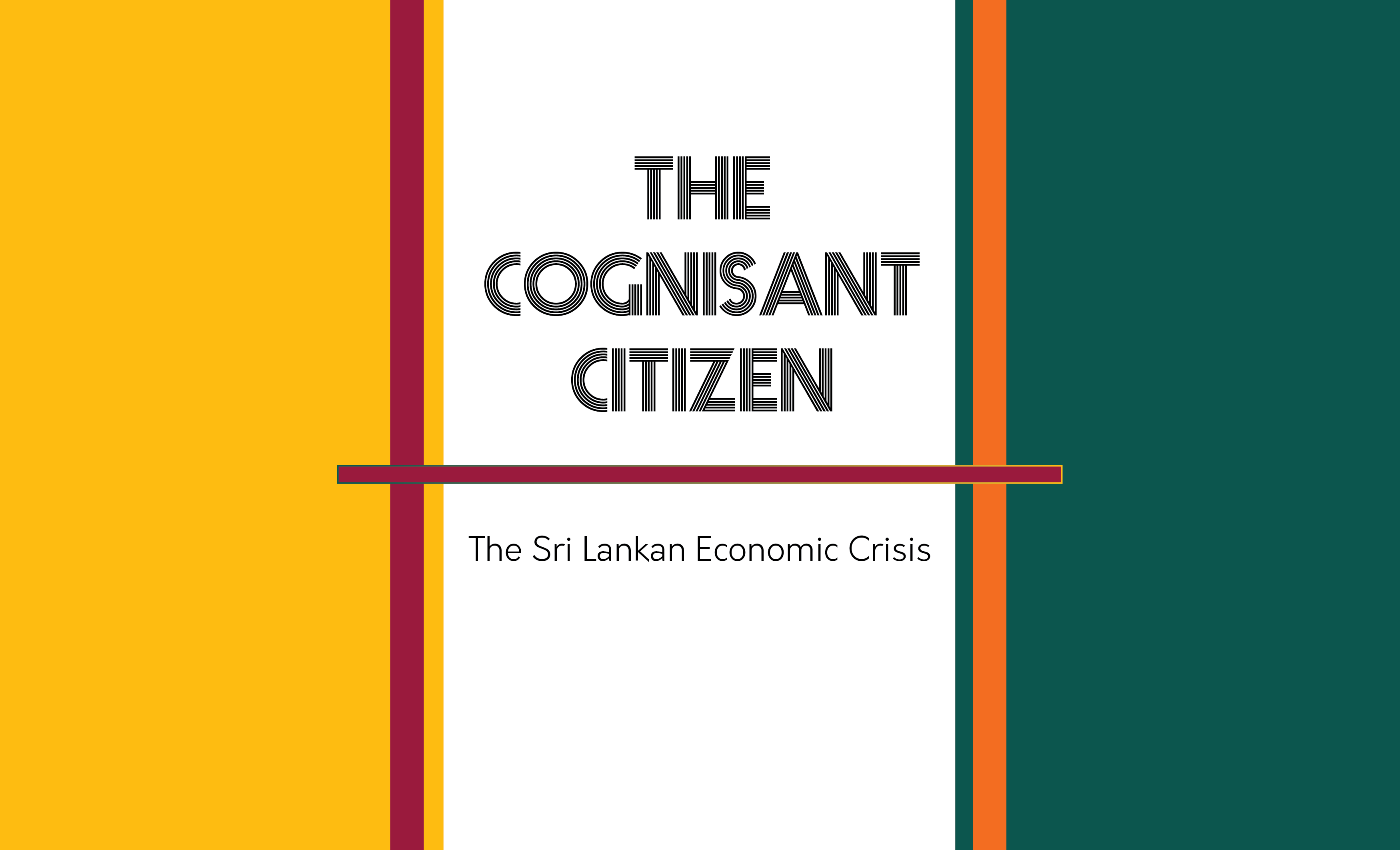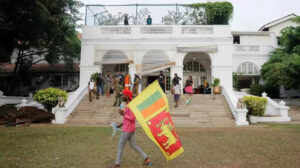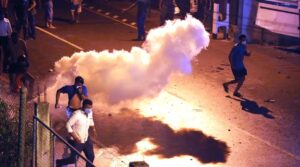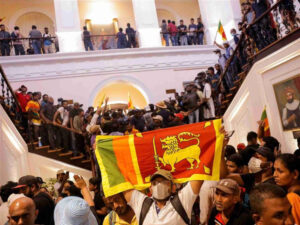
*Note: The information presented in this article is a conclusive account of the events that have transpired up until the morning of July 24th, 2022.

The functioning of a country is naturally, majorly influenced by the government in power. And often, it is the case that a “third-world” country will run into some form of financial crisis or issues that will require massive amounts of planning and investment to fix.
In the last six months, Sri Lanka has witnessed inherent turmoil at the hands of financial and political instability. This turmoil has been a long time in the making as Sri Lanka’s economy suffered a significant setback, directly and indirectly, due to the Sri Lanka Easter Sunday attacks; and a lack of tourism attributed to the COVID-19 pandemic. While this was only a part of the crisis, Sri Lanka’s financial planning, or lack thereof, led to the nation defaulting on its debts.
Following is the complete timeline of Sri Lanka’s present economic and national crisis:
November 2019 : Gotabaya’s Sri Lanka
The majority of the crisis stems from the hands of mismanagement by ex-president Gotabaya Rajapaksa and his dynastically ruling family. It is important to note that multiple family members held government portfolios in the Sri Lankan government. Gotabaya rose to the presidency by winning the 2019 Presidential Elections, an office which was last held by Mahinda Rajapaksa in 2015 after which he lost the Presidential Elections to the opposition. Shortly after Gotabaya was sworn in as the President, Mahinda was appointed as the Prime Minister.
November 2019: Mismanagement of the nation
Talks with Sri Lankan nationals suggest that economic mismanagement by successive governments had weakened Sri Lanka’s public finances, leaving national expenditure over income and the production of tradable goods and services at inadequate levels.
The Rajapaksa government, led by Mahinda Rajapaksa, dominated successive governments from 2005 to the present day, with the exception of the period from 2015 to 2019. Maithripala Sirisena assumed the presidency for that brief period of time.
The situation escalated with tax cuts enacted by the Rajapaksa government soon after it took office in 2019. Soon after, the COVID-19 pandemic took place. Although the pandemic was unforeseeable, the financial decisions ultimately proved unnecessary and lucrative to the crisis leading to its rock bottom.
November 2019: Exhaustion of the Foreign Exchange Reserves
Naturally, the government realised they had to do something to fix the declining situation. Again naturally, a government would have focused on the escalating inflation, and its foreign exports and imports. Whereas, the Sri Lankan government relied heavily on the foreign exchange reserves and thus eroded them by 70% in two years. The pandemic only further worsened the outcome of this decision as Lanka was soon left with barely any foreign resources to sustain trade.
April 2021: Organic Farming Disaster
A ban on chemical fertilisers in 2021 harmed the agricultural sector and food security, leaving many Sri Lankans to struggle with securing meals and their livelihoods. The ban impacted the country’s many industries including its big tea trade sector.
November 2021: Fall of the Sri Lankan Economy
Sri Lanka’s revenue base was wiped out, most notably their tourism industry. At the same time, remittances from nationals working abroad dropped and were further sapped away by an inflexible foreign exchange rate as the Sri Lankan Rupee fell noticeably.
The aforementioned 2019 tax cuts brought about by the Gotabaya government significantly reduced government revenues, hindering Sri Lanka’s ability to purchase essential items such as food, medicine, gas, and fuel.
Sri Lanka had begun its visible descent as soon as spring neared, Sri Lanka was requesting and pleading powers like Russia for fuel at discounted prices.
March 31st, 2022: Declaration of State Emergency
By now the people had realised the acute shortage of resources and had begun protesting outside the presidential residence. At the peak of this crisis, the peaceful protests outside the Gotabaya residency turned violent as protestors took to demand the resignation of the
Gotabayas. Gotabaya refused to step down from the Presidential chair alongside his brother Mahinda, in the Prime Ministers’ office. A state of emergency imposed shortly after did little to dissipate the protests, which grew further agitated with no proper solution in sight.
May 4th, 2022: Foreign Reserves reach Record Low
The country’s finance minister reported that Sri Lanka’s economy was in dire straits with its usable foreign reserves down to less than $50 million.
May 9th, 2022: Resignation of the Cabinet
Sri Lankan nationals have stated that many supporters of Gotabaya have also turned against him, in addition to the already wild Sri Lankan population. The people demanded the government to be replaced with one that was not corrupt and more adept at handling the situation, and in response, the cabinet resigned.
May 9th 2022: PM Mahinda Rajapaksa Resigns
Soon enough, in May, violence broke out as supporters of Mahinda Rajapaksa clashed with the protestors and caused further chaos fueled by a divided opposition government.
Mahinda suddenly resigned in hopes of quelling the violence, as his resignation was one of the demands, but his actions did little to change that. For the first time in the history of Sri Lanka, the government consisted of just the President and no one else.
The resignation of the Prime Minister and the cabinet was a clear indication for Gotabaya to follow suit as well. Supporters of Gotabaya argued that to turn the situation around, someone with considerable political experience had to remain in charge.
May 9th, 2022: Nationwide Curfew Imposed
Tensions only began to ease after the military imposed a curfew.
After Mahinda Rajapaksa resigned, Sri Lanka functioned for three days without a prime minister or a cabinet. With a split opposition and an isolated president, the country’s deteriorating political, economic, and security situation was troubling.

May 12th, 2022: Appointment of New PM and Cabinet
President Gotabaya appointed seasoned politician Ranil Wickremesinghe prime minister, and some individuals allegedly linked to the problem were subsequently appointed to the new cabinet, sparking questions about the new government’s legitimacy. It is important to note that Ranil Wickremesinghe was appointed the Prime Minister twice; once in 2015 and once more in 2018 due to political turmoil in the Maithripala Sirisena government.
July 2022: China and the Debt Restructure
China has engaged less publicly but has stated that it supports Sri Lanka’s efforts to restructure its debt. Rajapaksa asked China to restructure repayments on approximately $3.5 billion in debt, which included a $1.5 billion yuan-denomination exchange in late 2021.
July 2022: Support from India
India has allocated billions of dollars in loans to help pay for critical supplies, totalling more than $3.5 billion this year.
Since February, Sri Lanka has been battling a diesel shortage, resulting in hours of daily power outages. Sri Lanka is currently experiencing severe food and electricity shortages, leading the government to seek assistance from its neighbours.
NRIs living in Sri Lanka have returned home as resources become scarce and corporates in the country declare Work from Home.
Concerning flights to Sri Lanka, Union Aviation Minister Jyotiraditya Scindia praised Kerala airports for going above and beyond to assist the crisis-hit nation in a tweet.
“The airports have gone beyond their call of duty by allowing technical landing to 120+ aircraft bound for Sri Lanka. The gesture will go a long way in furthering ties with our neighbour.”
July 09th, 2022: Protesters Storm President’s Residence
Thousands of protesters clashed with police and broke through barricades to storm Sri Lankan President Gotabaya Rajapaksa’s official residence in Colombo, the capital city. According to local media, at least seven people were injured in the clash between protesters and police.

July 15th, 2022: Gotabaya Rajapaksa Resigns as President
Gotabaya Rajapaksa officially resigned as Sri Lanka’s President, the Parliamentary Speaker announced on Friday, putting an end to days of uncertainty since the deposed leader fled the island amid massive public protests over the country’s economic crisis.
July 15th, 2022: PM Wickremesinghe becomes Acting President
Prime Minister Ranil Wickremesinghe was sworn in as Acting President under the Constitution, even as members of Parliament prepared to elect a new President by secret ballot. Mr Abeywardana stated, “I hope to complete the process of electing a new President within seven days.”
July 20th, 2022: PM Ranil Wickremesinghe is elected President
Ranil Wickremesinghe, with 132 votes (out of 225 House votes) was elected by the Sri Lankan Parliament and will serve the remaining of his predecessor Gotabaya’s tenure, which began in November 2019.
July 21st, 2022: Dinesh Gunewardena becomes new PM
Dinesh Gunewardena was sworn in as Sri Lanka’s new Prime Minister. Gunawardena, 73, has previously served as foreign minister and education minister before being appointed Home Minister by then-President Gotabaya Rajapaksa in April.
July 22nd, 2022: Human Rights Group Urges President to protect protestors
International human rights organisations have urged Sri Lanka’s new president to immediately instruct security personnel to stop all unlawful use of force against protestors protesting the country’s economic collapse.
Despite protesters’ announcement that they would leave the location voluntarily after 100 days, troops rushed in and began beating demonstrators with batons and destroying tents leading to the President’s House.
July 23rd, 2022: Thousands of Artefacts Missing from Presidential Residence
Police claimed on Saturday that more than 1,000 precious artefacts, including vintage and antique antiques, had gone missing from Sri Lanka’s Presidential Palace and Prime Minister’s official residence at Temple Trees when enraged anti-government demonstrators besieged these sites a few weeks earlier.
July 24th, 2022: Human Rights Group Seeks Arrest of Former President Rajapaksa
The International Truth and Justice Project (ITJP), a human rights organisation has filed a criminal complaint with Singapore’s attorney general, seeking the arrest of former President Gotabaya Rajapaksa for his role in the South Asian country’s decades-long civil war.
According to the claims, Rajapaksa violated the Geneva Conventions while serving as the country’s defence commander during the civil war in 2009.
The people remain fearful of the government’s actions, but hope still stands tall as its neighbours continuously supply aid to the small island nation. Regular consignments of diesel and petrol reach the ports of burning Lanka to save it from the fire within. However, it still has a long way to go in terms of job security, food security and the overall well-being of Sri Lankans.
Sri Lanka was once seen as an example for other developing nations to follow, but now, the country is primarily seen as a crisis-stricken nation without fuel and electricity.
Written by Aditya Kapur for MTTN
Edited by Shivraj Herur for MTTN
Featured Image by Akshaya Ramesh for MTTN
Sources: Wikipedia, NDTV, The Indian Express, India Today, Al Jazeera
Images via India Today, Tribune India, AP Photo
Leave a Reply
You must be logged in to post a comment.